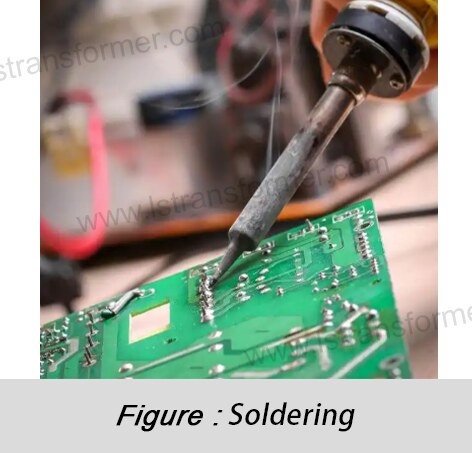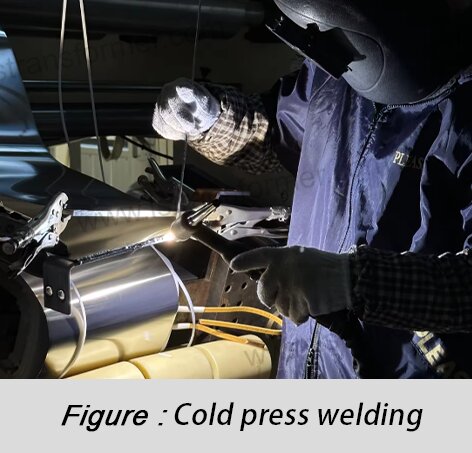¿Qué es más confiable: la soldadura láser, la soldadura blanda o el engarce en frío? Comparación de los procesos de unión de cables de bobinado.
¿Qué es más confiable: soldadura láser, soldadura blanda o engarce en frío?
—Una comparación de los procesos de unión de alambres de bobinado
En la fabricación de transformadores y reactancias, la elección del proceso de unión influye directamente en la eficiencia, la vida útil y la tasa de fallos del dispositivo. La soldadura láser, la soldadura blanda y el engarce en frío presentan diferencias significativas en conductividad, resistencia mecánica y estabilidad térmica. Cada método también conlleva riesgos potenciales de fallo que requieren una evaluación minuciosa. Por ejemplo, la zona afectada por el calor (ZAT) en la soldadura láser puede causar una distribución desigual de la corriente de alta frecuencia, el bajo punto de fusión de la soldadura puede provocar cortocircuitos secundarios durante sobrecargas, y los microhuecos en el engarce en frío pueden aumentar la resistencia de contacto con el tiempo. Este artículo compara las métricas principales y las consecuencias de fallo de estos procesos, haciendo referencia a normas internacionales (IEC 60076, IEEE C57.12.00), para proporcionar directrices de selección para aplicaciones de alta fiabilidad.
Contenido
1. Comparación de conductividad
● Soldadura láser
La unión metalúrgica en la soldadura láser proporciona una conductividad cercana a la del material base. Sin embargo, el engrosamiento del grano en la zona afectada por el calor (ZAC) puede aumentar la resistividad localizada. En los transformadores de alta frecuencia, esta microdistorsión agrava el efecto pelicular, causando sobrecalentamiento localizado y acelerando la carbonización del aislamiento. Por ejemplo, un estudio (IEEE Transactions on Power Delivery) demostró que las fluctuaciones de resistencia en la ZAC pueden aumentar las pérdidas de alta frecuencia entre un 5 % y un 8 %.
● Soldadura
La soldadura se basa en materiales de aleación, cuya resistividad inherente es aproximadamente seis veces mayor que la del cobre. Peor aún, la oxidación de la soldadura y las grietas por fatiga térmica pueden aumentar progresivamente la resistencia de contacto. En un caso (informe de EPRI), la resistencia de contacto de una unión soldada en un transformador sumergido en aceite aumentó un 30 % en tres años debido a la fluencia de la soldadura a 120 °C, lo que finalmente provocó la quema del devanado.
● Engarce en frío
El engarce en frío evita el daño térmico por compresión mecánica, pero los microhuecos pueden generar microarcos bajo el flujo de corriente, y la oxidación puede aumentar gradualmente la resistencia de contacto. Una investigación de la NASA descubrió que los engarces en frío sin recubrimiento, sometidos a ciclos extremos de temperatura espacial, mostraron un aumento de la resistencia del 15 % al 20 % a lo largo de una década.
Proceso | Resistividad inicial | Mecanismo de degradación primaria | Consecuencias típicas |
Soldadura por láser | ~1.68×10⁻⁸ Ω·m | Engrosamiento del grano HAZ | Puntos calientes de alta frecuencia, envejecimiento del aislamiento |
Soldadura | ~10⁻⁷ Ω·m | Oxidación/fluencia/fatiga térmica | Sobrecalentamiento, cortocircuitos secundarios |
Engarce en frío | ~2×10⁻⁸ Ω·m | Oxidación por microvacíos | Deriva de la resistencia de contacto, microarcos |
Tabla 1: Comparación de conductividad y riesgo a largo plazo
2. Comparación de resistencia mecánica
● Soldadura láser
Si bien las soldaduras láser pueden alcanzar el 90 % de la resistencia del material base, la tensión residual y la fragilización de la ZAC reducen la resistencia a la fatiga. El caso de un transformador de turbina eólica (Wind Energy Journal) reveló grietas por fatiga originadas en la ZAC tras ocho años de vibración, lo que provocó la fractura del devanado.
● Soldadura
La soldadura ofrece la resistencia mecánica más baja (30-50 MPa), y la tensión por ciclos térmicos puede causar grietas en las uniones. Los datos de reactores automotrices mostraron que las uniones soldadas fallaban después de 2,000 ciclos de temperatura (-40 °C a 125 °C), mientras que las soldaduras láser resistieron más de 5,000 ciclos.
● Engarce en frío
La resistencia del engarce en frío depende de la velocidad de compresión, pero un engarce excesivo puede cortar las fibras del cable y debilitar la unión. Las estadísticas de la industria (ICEA S-97-682) indican que el 12 % de las fallas en campo se deben a una compresión insuficiente debido al desgaste de la matriz.
3. Comparación de estabilidad térmica
● Soldadura láser
Las soldaduras láser comparten el punto de fusión del material base (cobre: 1083 °C), pero un enfriamiento rápido puede generar fases frágiles. Un análisis de fallos de transformadores ferroviarios de alta velocidad (EN 50329) atribuyó la fractura frágil a la excesiva dureza de la soldadura bajo fuerzas de cortocircuito.
● Soldadura
El defecto crítico de la soldadura es su bajo punto de fusión. En las pruebas de certificación UL, la soldadura sin plomo (SAC305) se ablandó a 217 °C, lo que provocó cortocircuitos entre espiras durante sobrecargas del 150 %.
● Engarce en frío
Si bien es resistente al calor, la relajación de la tensión reduce la presión de contacto con el tiempo. Las pruebas ASTM B542 mostraron una disminución del 18 % en la fuerza de engarce en terminales de cobre después de 1,000 horas a 150 °C, lo que requirió sellos elásticos para compensarlo.
Directrices de selección de procesos
Escenario de aplicación | Proceso recomendado | Medidas clave de mitigación de riesgos |
Alta frecuencia/alta temperatura (por ejemplo, aeroespacial) | Soldadura láser | Protección con argón para reducir la oxidación, tratamiento térmico posterior a la soldadura |
Reparaciones de bajo costo y baja frecuencia | Soldadura | Soldadura con alto contenido de plata (Sn96Ag4), refuerzo mecánico |
Transformadores de potencia producidos en masa | Engarce en frío | Plateado, calibración regular de matrices |
En resumen
La soldadura láser, la soldadura blanda y el crimpado en frío ofrecen ventajas distintivas para la unión de cables de bobinado. La soldadura láser destaca por su conductividad y resistencia mecánica, lo que la hace ideal para aplicaciones de alta fiabilidad, como entornos de alta frecuencia o alta temperatura, aunque el control de la ZAT es fundamental. La soldadura blanda es rentable y fácil de realizar, pero se limita a reparaciones de baja frecuencia, baja potencia o temporales debido a su bajo punto de fusión y al riesgo de oxidación. El crimpado en frío ofrece el mejor equilibrio entre coste y estabilidad para la producción en masa, siempre que el plateado y el mantenimiento de la matriz solucionen los problemas de microhuecos y relajación de tensiones. Los avances futuros, como la monitorización de la resistencia basada en IoT y el crimpado híbrido asistido por láser, podrían mejorar aún más la fiabilidad y la adaptabilidad en la fabricación de transformadores.
Contáctenos
lushan, est.1975Es un fabricante profesional chino especializado en transformadores y reactores de potencia con más de 50 años de experiencia. Nuestros productos líderes son...transformador monofásico, transformadores de aislamiento trifásicos, transformador eléctrico, transformador de distribución, transformador reductor y elevador, transformador de baja tensión, transformador de alta tensión, transformador de control, transformador toroidal, transformador de núcleo R; inductores de CC, reactores de CA, reactor de filtrado, reactor de línea y carga, estranguladores, reactor de filtrado y productos intermedios de alta frecuencia.
Nuestros transformadores y reactores de potencia se utilizan ampliamente en 10 áreas de aplicación: tránsito rápido, maquinaria de construcción, energía renovable, fabricación inteligente, equipos médicos, prevención de explosiones en minas de carbón, sistema de excitación, sinterización al vacío (horno), aire acondicionado central.
Conozca más sobre transformadores de potencia y reactores:www.lstransformer.com.
Si desea obtener soluciones personalizadas para transformadores o reactancias, póngase en contacto con nosotros.
WhatsApp:+86 17267488565
Correo electrónico: marketing@hnlsdz.com

 EN
EN
 FR
FR DE
DE ES
ES


